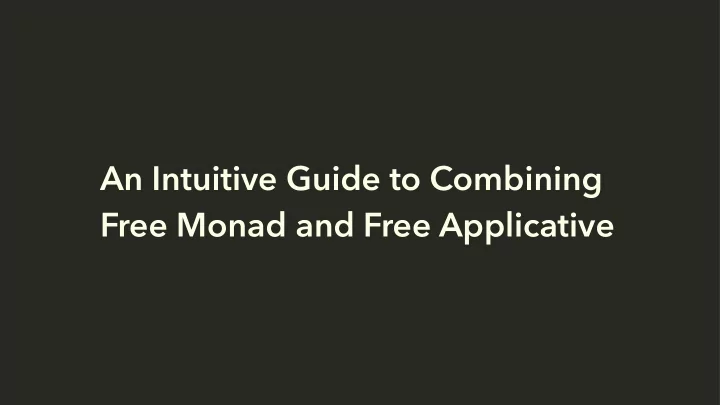

An Intuitive Guide to Combining Free Monad and Free Applicative
Who Am I? • I'm Cameron • Linkedin - https://www.linkedin.com/in/cameron-joannidis/ • Twitter - @CamJo89 • Consult across a range of areas and have built many big data and machine learning systems • Buzz Word Bingo • Big Data • Machine Learning • Functional Programming
Agenda • Abstracting effects from domain definitions • Abstracting effects with Free Structures • Combining Free and FreeAp
Before We Start • I am not advocating that you should be using Free Monad and/or Free Applicative over final tagless. Every team and project is different and both approaches are sufficiently powerful for most requirements • I'm hoping to introduce you more generally to some more interesting things you can do with Free Structures • Source Code: https://github.com/camjo/presentations
A Basic Domain
A Basic Implementation
Capturing Failure
Capturing Async Effects
Combining Multiple Effects
What Happened to our Domain?
Problems • Tightly couples implementation details to domain • Can’t test domain logic in isolation of implementation
Final Tagless
Final Tagless Implementation
Free Monad
Operations as Data
Lifting Operations into Free Monad
Sequencing Operations
Our Program
Interpreting Program (Data)
Interpreting Program (Data)
Interpreting Program (Data)
Free (Monad) / FreeAp (Applicative) • Encode domain as ADT • Lift domain into Free structure • Write logic as a Free program • Create interpreters to interpret domain instructions with some effect • Interpret Free program to produce output effect
Free (Monad) / FreeAp (Applicative) • Encode domain as ADT • Lift domain into Free structure • Write logic as a Free program • Create interpreters to interpret domain instructions with some effect • Interpret Free program to produce output effect
Operations as Data
Our Domain as an ADT
Our Domain as an ADT
Free (Monad) / FreeAp (Applicative) • Encode domain as ADT • Lift domain into Free structure • Write logic as a Free program • Create interpreters to interpret domain instructions with some effect • Interpret Free program to produce output effect
Lifting Operations into Free Monad
Lifting Operations into Free Monad
Lifting Operations into FreeAp
Lifting Operations into FreeAp
A Little Trick • Lets us defer the choice of using a monad effect type or an applicative effect type until we actually use it • Can be extended to any Free structure in theory
Creating our Repo with ExecStrategy Allows us to defer the choice of Free Monad vs. Free Applicative
Free (Monad) / FreeAp (Applicative) • Encode domain as ADT • Lift domain into Free structure • Write logic as a Free program • Create interpreters to interpret domain instructions with some effect • Interpret Free program to produce output effect
DEPENDENT OPERATIONS E.G. SEQUENTIAL FREE MONAD
Operations in Sequence
INDEPENDENT OPERATIONS E.G. PARALLELISM FREE APPLICATIVE
Operations in Parallel
HOW DO WE COMBINE SEQUENTIAL AND PARALLEL OPERATIONS?
Instruction Set
Two Main Choices • Parallel program of sequential steps
Parallel Program of Sequential Steps
Two Main Choices • Parallel program of sequential steps • Sequential program of parallel steps
Sequential Program of Parallel Steps
Lifting Operations into Program • Free needs to wrap internal Operation with FreeAp • FreeAp steps need to be wrapped in Free
Lifting a Free Applicative into the Free Monad • Its as simple as the code below • The other .asProgramStep definition is a tad more involved. (See the code on Github for how to do it. )
Two (Simple) Domains
Lift Domain • Handling the combination of multiple domains by making the domain functor generic as F
Lift Domain • Handling the combination of multiple domains by making the domain functor generic as F
Writing Our Program
Program Structure
Writing Our Program (Another Way)
Program Structure
Free (Monad) / FreeAp (Applicative) • Encode domain as ADT • Lift domain into Free structure • Write logic as a Free program • Create interpreters to interpret domain instructions with some effect • Interpret Free program to produce output effect
Interpreting an Operation
User Interpreter We make it slow so that we can easily observe the difference in runtime between the sequential and parallel versions
Our Interpreter We make it slow so that we can easily observe the difference in runtime between the sequential and parallel versions
Free (Monad) / FreeAp (Applicative) • Encode domain as ADT • Lift domain into Free structure • Write logic as a Free program • Create interpreters to interpret domain instructions with some effect • Interpret Free program to produce output effect
Combining Our Domains • Define our operations as a common instruction set • Combine out interpreters to read this instruction set
Creating Program Instructions
Creating Program Instructions
Creating Program Instructions
Interpreting Program Instructions
Interpreting Program Instructions
Interpreting Program Instructions
Interpreting Program Instructions
Interpreting Program Instructions
Making it Parallel • Our Free Monads operation type was FreeAp[F, ?] • Provide a way to turn that into our output effect G in parallel (using Applicative)
Running the Program
Program 1
Program Results
Program 2
Program Results
Things to Note • Target effect must have an applicative instance • Default Task applicative instance runs sequentially left to right (i.e. not in parallel - since it is also a monad) • Need to explicitly import parallel applicative instance or create your own in scope (See github code example for how) • We can remove most usages of .asProgramStep with implicits
Freestyle - Removing the Boilerplate • Freestyle (frees.io) uses macros to remove most of the boilerplate • Defaults to using the Free[FreeAp[F, ?], A] approach that we used • Several integrations and library abstractions out of the box • Out of the box optimisations to reduce the overhead of using many domain algebras
What We’ve Covered • Why we abstract effects from domain • Abstracting effects with Final Tagless or Free Structures • Combining Free and FreeAp to introduce parallelism into our domain • Freestyle to remove boilerplate
@CamJo89 Thank You Questions?
Recommend
More recommend